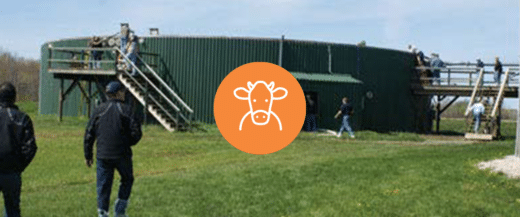
Project Type
Agriculture Methane Reduction
Standard
Climate Action Reserve
Project Location
Krakow, WI
SDG Impacts
![]()
The United Nations' Sustainable Development Goals (SDGs) are an urgent call for action by countries in global partnership to end poverty, protect the planet, and ensure that by 2030 all people enjoy peace and prosperity.
Project Profile
Green Valley Dairy Methane Reduction Project
 In 2020, the agriculture sector was responsible for nearly 10% of total U.S. greenhouse gas emissions. Dairy cattle accounted for roughly 25% of agriculture’s overall methane emissions that year. Introducing advanced manure management practices is a highly effective method for mitigating the environmental impact of dairy farming. It was this opportunity that caught the attention of Wisconsin-based Green Valley Dairy. Prior to installing their three anaerobic digesters in 2006, the dairy was storing manure from its 3,000 milking cows, 300 dry cows and 300 heifers in open lagoons. Without a cover, this manure decomposed under anaerobic conditions, releasing methane gas into the atmosphere. With the new system, the Green Valley Dairy sends manure through an underground pipe network to its digesters. Methane gas is then captured and destroyed in two 1.2 MW generators to produce electricity and heat, thus displacing fossil fuel use. Aside from their ability to reduce harmful GHG emissions, dairy digester projects also improve air quality, add diversity to the fuel supply, and increase energy security with a cost-effective renewable resource. Digester projects range from $5-20 million to implement. Carbon credits from avoided methane emissions provide the dairy with an important stream of revenue to help make these projects economically viable.
In 2020, the agriculture sector was responsible for nearly 10% of total U.S. greenhouse gas emissions. Dairy cattle accounted for roughly 25% of agriculture’s overall methane emissions that year. Introducing advanced manure management practices is a highly effective method for mitigating the environmental impact of dairy farming. It was this opportunity that caught the attention of Wisconsin-based Green Valley Dairy. Prior to installing their three anaerobic digesters in 2006, the dairy was storing manure from its 3,000 milking cows, 300 dry cows and 300 heifers in open lagoons. Without a cover, this manure decomposed under anaerobic conditions, releasing methane gas into the atmosphere. With the new system, the Green Valley Dairy sends manure through an underground pipe network to its digesters. Methane gas is then captured and destroyed in two 1.2 MW generators to produce electricity and heat, thus displacing fossil fuel use. Aside from their ability to reduce harmful GHG emissions, dairy digester projects also improve air quality, add diversity to the fuel supply, and increase energy security with a cost-effective renewable resource. Digester projects range from $5-20 million to implement. Carbon credits from avoided methane emissions provide the dairy with an important stream of revenue to help make these projects economically viable.
CO-BENEFITS:

Environmental:
Installing anaerobic digester equipment eliminates the environmental degradation and climate pollutant emissions associated with the standard method of manure disposal into open lagoons. The liquid from the manure was recycled into fertilizer for Green Valley’s fields, which benefitted from its nutrients.
 Economic:
Economic:
The anaerobic digesters produce effluent that can be used as organic fertilizer or animal bedding. Biosolid bedding produced by the digester saves $245,000 in sand bedding costs annually and reduces emissions created by hauling bedding to and from the dairy. Green Valley Dairy provided cost savings to nearby dairies and landscaping companies by selling them recycled bedding for significantly less than the cost of alternatives.
![]()
Health:
Digesters reduce manure odor in the local community, which can be significant in areas with large concentrations of dairy cows. Animal manure is useful as a natural fertilizer due to the presence of nutrients like nitrogen and potassium; however, an overabundance of these nutrients can cause harmful ecological imbalances in soil and waterways. Digester projects help dairy farms better manage and apply these nutrients to farmland and avoid accidental runoff.
3Degrees + carbon offsets
View other project profiles or contact us.